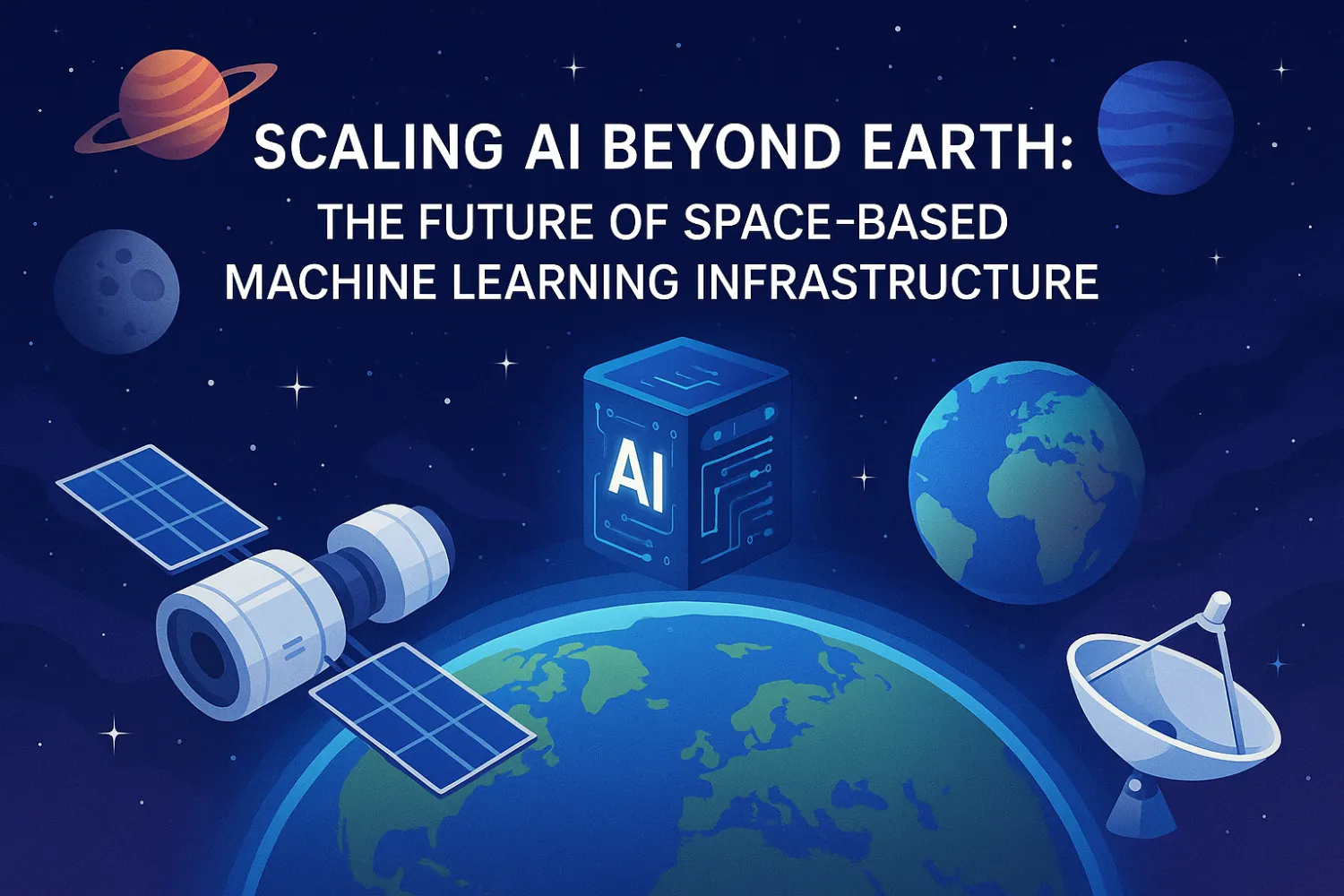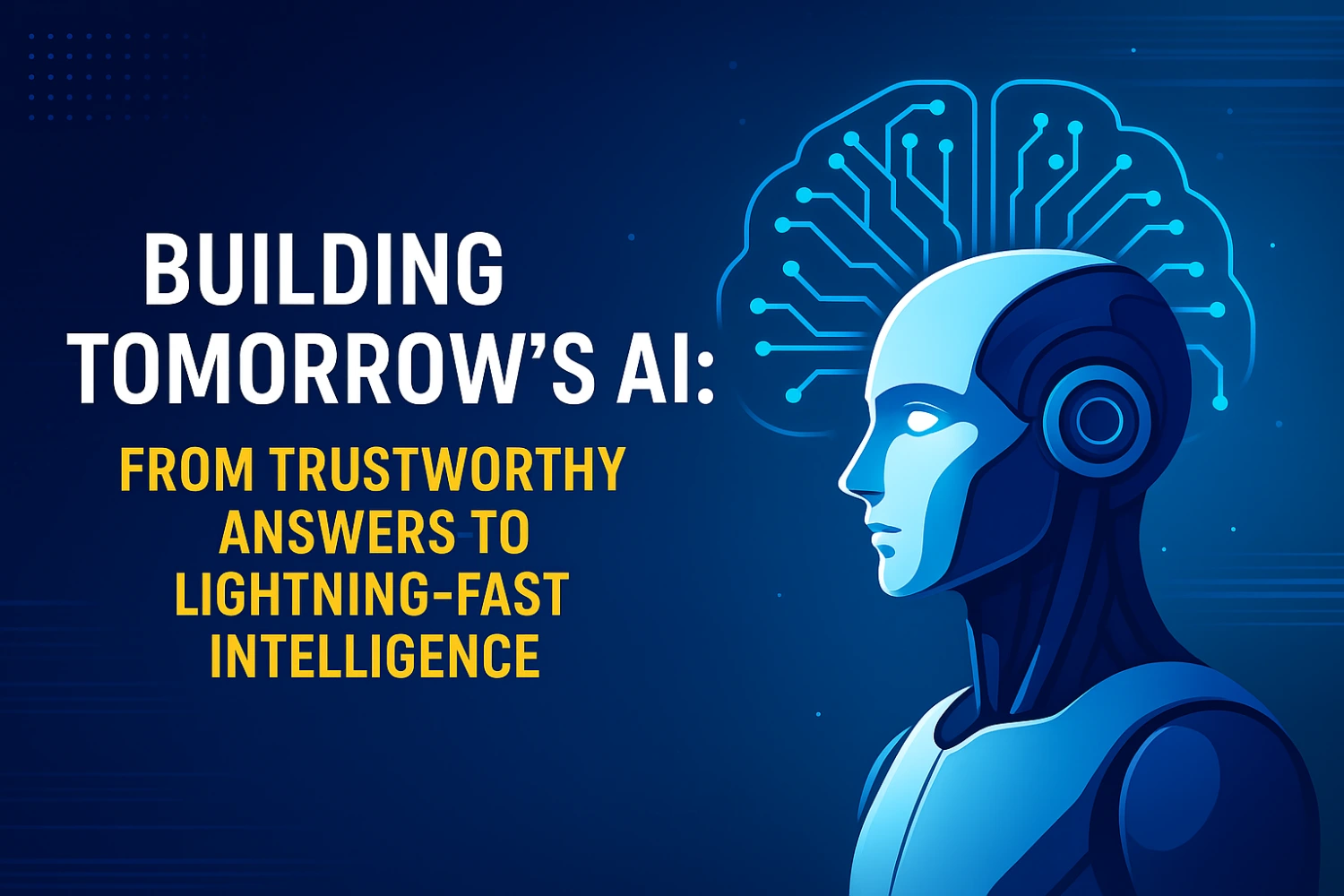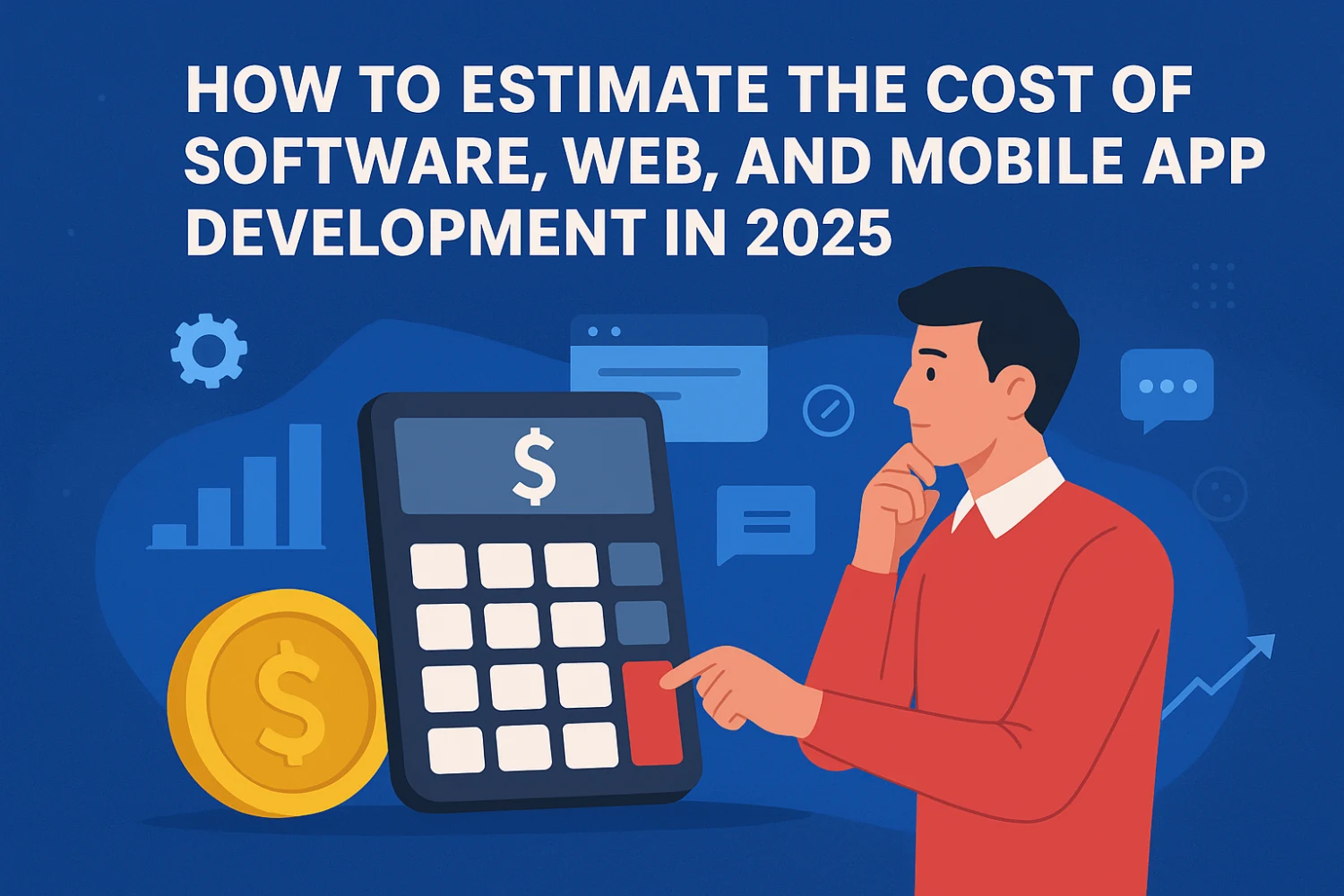Introduction
Artificial intelligence has transformed how we work, create, and solve problems—but we're rapidly approaching the limits of what Earth-based infrastructure can support. As AI models grow exponentially more powerful and demanding, the question isn't just how we build better data centers—it's where we build them. The answer might be 650 kilometers straight up.
In November 2025, a groundbreaking research initiative revealed plans that sound like science fiction: networks of solar-powered satellites equipped with AI processors, orbiting Earth in tight formation, harnessing the unlimited power of the Sun to run machine learning workloads at unprecedented scale. This isn't a distant dream—prototype satellites are scheduled to launch by early 2027.
For businesses, developers, and technology leaders, this represents more than an engineering marvel. It signals the next frontier in computational infrastructure—one that could fundamentally reshape how AI systems are trained, deployed, and scaled. The race to space-based computing has begun, and understanding its implications is crucial for anyone planning long-term AI strategy.
The Power Problem: Why Earth-Based AI Infrastructure Is Hitting a Wall
Modern AI development faces a brutal reality: training cutting-edge models requires staggering amounts of energy. Large language models and sophisticated neural networks can consume megawatts of power during training runs that last weeks or months. Data centers are racing to secure energy supplies, often competing with residential and commercial electricity needs.
Meanwhile, the Sun—our solar system's ultimate power source—emits more energy than 100 trillion times humanity's total electricity production. In Earth's orbit, that power is available almost continuously, without weather interference, seasonal variation, or nighttime interruptions.
The Orbital Advantage
Space offers computational infrastructure advantages that terrestrial facilities simply cannot match:
Continuous Solar Power: Satellites in sun-synchronous low Earth orbits experience near-constant sunlight exposure. Solar panels in these orbits can generate up to eight times more power than equivalent panels on Earth's surface, operating around the clock without requiring massive battery arrays.
Thermal Management: Space provides the ultimate heat sink. While data centers on Earth spend enormous energy on cooling systems, space-based systems can radiate heat directly into the vacuum, dramatically simplifying thermal management at scale.
Unlimited Expansion: Earth's geography and regulatory environment limit where data centers can be built. Space offers essentially unlimited room for expansion, constrained only by orbital mechanics and economics rather than real estate availability.
Reduced Environmental Impact: By moving intensive computation off-planet, space-based infrastructure eliminates the local environmental footprint of massive data centers—no water consumption for cooling, no land development, no heat island effects.
The Vision: Solar-Powered Satellite Constellations Running AI at Scale
Imagine a network of compact satellites flying in precise formation, each equipped with specialized AI processors, connected through laser-based optical links capable of transmitting data at terabits per second. These aren't massive spacecraft—they're efficient, purpose-built platforms designed to work together as a distributed computing system.
The Architecture: How Space-Based AI Clusters Work
The proposed system centers on several key innovations working in concert:
Dawn-Dusk Sun-Synchronous Orbits: Satellites orbit at approximately 650 kilometers altitude, timed to maintain constant sunlight exposure throughout their orbit. This "dawn-dusk" configuration maximizes solar collection while minimizing the need for energy storage.
Close-Formation Satellite Clusters: To achieve the bandwidth necessary for distributed machine learning, satellites fly in tight formation—just hundreds of meters apart rather than the thousands of kilometers typical in satellite constellations. An 81-satellite demonstration cluster within a one-kilometer radius has been modeled, with each satellite maintaining precise positioning relative to its neighbors.
Free-Space Optical Communication: Rather than traditional radio frequency links, satellites communicate through free-space optical connections—essentially high-powered laser data transmission. Laboratory tests have already demonstrated 1.6 terabits per second total capacity (800 gigabits each direction) using prototype systems. Multi-channel dense wavelength-division multiplexing enables multiple data streams simultaneously, scaling bandwidth to the tens of terabits per second required for distributed AI workloads.
AI-Optimized Processors in Space: Tensor Processing Units—specialized chips designed specifically for machine learning operations—form the computational heart of each satellite. These aren't general-purpose computers; they're purpose-built accelerators optimized for the matrix operations that dominate neural network training and inference.
Formation Flight: The Orbital Dance
Maintaining stable formations with satellites flying mere hundreds of meters apart presents extraordinary challenges. Small perturbations from gravitational irregularities, atmospheric drag at orbital altitudes, and other forces could cause satellites to drift or collide.
Advanced orbital mechanics modeling using specialized equations simulates exactly how satellite clusters behave under Earth's gravitational influence. These simulations reveal something remarkable: with satellites positioned in close proximity, only modest station-keeping maneuvers are needed to maintain stable formations within the desired sun-synchronous orbit.
The system essentially allows satellites to "free-fall" together in a coordinated fashion, with machine learning-based control systems making precise adjustments as needed. This elegant solution minimizes fuel requirements and extends mission lifetimes while maintaining the tight formations essential for high-bandwidth optical communication.
Surviving the Radiation Environment: Making AI Chips Space-Worthy
Space is hostile to electronics. Cosmic rays, solar radiation, and high-energy particles constantly bombard satellites in orbit, causing cumulative damage and instantaneous faults that can corrupt data or crash systems. For AI processors containing billions of transistors and high-density memory, this radiation environment poses existential threats.
Radiation Testing: Pushing TPUs to Their Limits
Comprehensive testing subjected advanced TPU processors to 67 MeV proton beams—simulating years of exposure to the penetrating radiation experienced in low Earth orbit. The chips were protected only by the level of shielding realistically deployable on space missions, providing honest assessment of real-world survivability.
The results exceeded expectations:
Impressive Radiation Tolerance: No permanent hardware failures occurred even at total ionizing doses of 15 krad—roughly twenty times the expected five-year mission exposure of 750 rad. The processors demonstrated surprising inherent radiation hardness without specialized space-grade modifications.
Memory Subsystem Resilience: High Bandwidth Memory (HBM), the most radiation-sensitive component, only began showing irregularities at 2 krad—still nearly three times the expected mission dose. The error rates observed are likely acceptable for inference workloads, where occasional computational errors have minimal impact on overall results.
Training Considerations: While inference appears viable, the impact of single-event effects—instantaneous faults caused by individual particle strikes—on lengthy training runs requires further study. However, the fundamental radiation hardness observed suggests that with modest error correction and redundancy, training workloads are feasible.
This radiation resilience is critical. In traditional data centers, failing hardware gets replaced within hours. In space, with no technicians available for repairs, components must survive for years. Redundant provisioning—launching extra capacity to compensate for inevitable failures—becomes the practical solution, adding cost but ensuring mission success.
The Economics: When Does Space Computing Make Financial Sense?
The most ambitious technology ultimately succeeds or fails on economics. Launching satellites is expensive, and historically, space operations have carried premium price tags. But the launch industry is undergoing its own revolution.
The Declining Cost Curve
Launch costs have plummeted over the past decade, driven by reusable rocket technology and increased competition. Current costs range from $1,500 to $2,900 per kilogram to low Earth orbit, depending on specific mission requirements. But learning curve analysis—examining how costs decline as production scales—suggests dramatic further reductions are coming.
Projections indicate launch costs may fall below $200 per kilogram by the mid-2030s. At that price point, something remarkable happens: the cost of launching and operating a space-based data center could become roughly comparable to the reported energy costs of an equivalent terrestrial facility, measured per kilowatt-year of operation.
This economic crossover doesn't account for all factors—ground communication infrastructure, mission control, and system reliability all add complexity. But it suggests that within a decade, space-based computing could compete economically with traditional data centers for certain workloads, particularly those requiring massive scale and continuous operation.
The Value Proposition: More Than Just Economics
Cost parity isn't the only consideration. Space-based infrastructure offers strategic advantages:
- Energy Independence: No reliance on terrestrial power grids or energy markets
- Scalability: Adding capacity means launching more satellites rather than negotiating real estate and utility connections
- Sustainability: Eliminating local environmental impacts of massive data centers
- Redundancy: Distributed systems with no single point of failure
- Future-Proofing: Positioning early in what may become the dominant AI infrastructure paradigm
For enterprises planning decade-long AI roadmaps, understanding these dynamics shapes strategic planning even if immediate deployment remains years away.
From Research to Reality: The 2027 Prototype Mission
Theory and simulation only take you so far. The next critical milestone tests these concepts in the unforgiving environment of actual space operations.
The Learning Mission
In partnership with Planet, a leading satellite operator, two prototype satellites are scheduled to launch by early 2027. This learning mission has focused objectives:
Hardware Validation: Testing how TPU processors and supporting systems operate under real orbital conditions—vacuum, thermal cycling, radiation exposure, microgravity effects, and the mechanical stresses of launch and deployment.
Optical Link Demonstration: Validating that free-space optical communication works reliably between satellites in orbit, not just in controlled laboratory conditions. This includes testing pointing accuracy, signal acquisition, atmospheric effects during ground communication, and maintaining connections through orbital dynamics.
Distributed ML Workloads: Running actual machine learning tasks distributed across multiple satellites, proving that the fundamental concept of space-based AI computation is viable. This isn't about peak performance—it's about demonstrating the architecture works end-to-end.
System Integration: Testing how all components—power generation, thermal management, communication systems, and computation—work together as an integrated platform.
This mission is explicitly a learning experiment, designed to reveal problems and drive iterations. Success means identifying and solving critical challenges before attempting larger-scale deployments. Failure means learning what needs to change. Either outcome advances toward the ultimate goal of scalable space-based AI infrastructure.
The Broader Movement: Space Computing Goes Mainstream
This satellite-based AI initiative doesn't exist in isolation. A wave of companies, researchers, and entrepreneurs are simultaneously pursuing space-based computing from different angles.
Recent announcements include competing projects aiming to deploy data centers in orbit, satellite launches carrying AI processors for testing, and major technology leaders publicly discussing space-based infrastructure as inevitable. The race is accelerating, with multiple parallel approaches exploring different architectures, orbits, and use cases.
This convergence signals that space-based computing has crossed a threshold—from speculative concept to serious engineering effort backed by substantial investment. For businesses, this means the question isn't if space-based infrastructure will exist, but when it becomes commercially accessible and how to position for that transition.
Real-World Applications: What Space-Based AI Enables
Beyond the engineering spectacle, what practical applications justify orbiting data centers?
Scientific Research and Simulation
Complex climate modeling, astrophysical simulations, and molecular dynamics calculations requiring sustained computation at massive scale could leverage continuous solar power and unlimited expansion capacity. Research organizations could rent space-based compute capacity for intensive projects without energy constraints.
Global AI Services
Inference services for large language models, computer vision systems, and other AI applications could operate from orbit, serving global users with minimal latency through distributed ground stations. The continuous operation and thermal efficiency make space ideal for always-on AI services.
Edge Computing for Satellite Systems
Earth observation satellites, communication constellations, and remote sensing platforms generate enormous data volumes. Processing that data in orbit—before downlinking—dramatically reduces bandwidth requirements and enables real-time analysis. Space-based AI clusters become the "edge" processing layer for orbital sensors.
Autonomous Space Systems
As human activity expands beyond Earth—satellite servicing, space manufacturing, eventual lunar and Mars missions—AI systems managing autonomous operations benefit from co-located computation. Training and updating models in space eliminates the light-speed delays of Earth-based control.
Sustainable AI Development
Organizations committed to reducing environmental impact could prioritize space-based training for massive models, eliminating the carbon footprint and local environmental effects of terrestrial data centers while maintaining computational capability.
Navigating the New Frontier: How True Value Infosoft Prepares Businesses for Space-Age AI
The emergence of space-based computing infrastructure creates strategic implications for businesses across industries. While orbital data centers remain years from routine commercial operation, the technology trajectory is clear—and early preparation creates competitive advantage.
Our Strategic Approach to Future AI Infrastructure
At True Value Infosoft (TVI), we help organizations navigate technological transitions by combining practical implementation with forward-looking architecture. Our approach to the space computing era focuses on positioning clients for emerging capabilities:
Hybrid Architecture Planning: We design AI systems with modular architectures that can leverage both terrestrial and future space-based infrastructure. This means building applications that distribute workloads intelligently, scale across diverse computing environments, and adapt as new infrastructure options become available.
Workload Characterization: Not all AI tasks belong in space. We help identify which workloads benefit most from continuous operation, massive scale, and distributed processing—the sweet spots for future orbital deployment—versus tasks better suited for terrestrial infrastructure or edge computing.
Sustainable AI Strategy: For organizations prioritizing environmental responsibility, we architect AI systems that maximize efficiency today while positioning for migration to sustainable space-based infrastructure as it matures. This includes renewable energy integration, efficient model design, and preparation for hybrid Earth-space deployment models.
Cutting-Edge Infrastructure Expertise: Our team stays current with emerging computing paradigms—from distributed optical networks to radiation-hardened systems—ensuring we can guide clients through infrastructure transitions as they unfold. When space-based commercial AI services launch, we'll be ready to integrate them into client architectures.
Future-Ready AI Development: We build AI applications designed for portability and adaptability. Whether deployed on cloud platforms today, hybrid cloud-edge infrastructure tomorrow, or distributed across Earth and orbital systems in the future, our solutions maintain flexibility and performance across evolving deployment scenarios.
End-to-End AI Solutions for Today and Tomorrow
While space-based infrastructure develops, businesses need AI solutions that deliver value now:
- Cloud-Native AI Applications: Building scalable, efficient AI systems on current infrastructure that adapt as new options emerge
- Distributed System Architecture: Designing applications that work across geographically distributed compute resources—skills directly applicable to future Earth-space hybrid systems
- Energy-Efficient AI: Optimizing models and infrastructure for minimal power consumption, reducing costs today and preparing for future space deployments where every watt counts
- Continuous Learning Systems: Implementing AI that improves through operation, positioning for scenarios where continuous training on orbital infrastructure becomes advantageous
- Mission-Critical Reliability: Building AI systems with the fault tolerance, redundancy, and monitoring required for high-stakes deployments—expertise directly relevant to space-based operations where maintenance is impossible
The convergence of AI and space infrastructure isn't a distant fantasy—it's an approaching reality that forward-thinking organizations are preparing for today.
Ready to Build AI for Tomorrow's Infrastructure?
The future of AI computation extends beyond traditional data centers, embracing new frontiers that seemed impossible just years ago. While space-based infrastructure matures from research projects to commercial reality, the strategic implications are clear: AI systems will increasingly leverage diverse computing environments, from edge devices to cloud platforms to orbital processors.
At True Value Infosoft, we help businesses navigate this evolving landscape with practical solutions today and strategic vision for tomorrow. Whether you're developing new AI applications, optimizing existing systems, or planning long-term infrastructure strategy, we provide the expertise to build solutions that adapt as the computational landscape transforms.
Let's explore how your AI strategy can prepare for tomorrow's possibilities while delivering exceptional value today. Connect with True Value Infosoft to discuss how we can architect AI solutions that scale from current infrastructure through the space age and beyond.
The future of AI is being built today—on Earth and increasingly beyond it. The question is whether your organization will lead this transformation or watch from the sidelines.
FAQs
Space offers advantages impossible to achieve terrestrially: continuous solar power up to 8x more productive than Earth-based panels, unlimited expansion room without geographic constraints, efficient thermal management through direct heat radiation, and elimination of local environmental impacts. As launch costs decline, these benefits could make space-based infrastructure economically competitive for specific AI workloads requiring massive continuous computation.
Free-space optical communication—essentially laser-based data transmission—enables terabit-per-second bandwidth between satellites flying in close formation (hundreds of meters apart). Multiple wavelength channels operating simultaneously achieve the tens of terabits per second needed for distributed machine learning. Laboratory tests have already demonstrated 1.6 Tbps bidirectional communication, proving the concept's viability.
Testing shows modern AI processors are surprisingly radiation-tolerant. Advanced TPU chips survived radiation exposure equivalent to 20 years in orbit without permanent failures, even with only modest shielding. While memory systems show some sensitivity at extreme doses, error rates remain acceptable for inference workloads and manageable for training with appropriate error correction and redundancy.
Prototype satellites launching in 2027 will validate core concepts, but commercial deployment likely requires another 5-10 years of development. Launch cost reductions approaching $200/kg projected for the mid-2030s could make space-based computing economically viable at scale. Early adopters may access specialized space-based AI services by the early 2030s.
Design AI systems with modular, distributed architectures that can adapt to diverse computing environments. Focus on workload characterization to identify tasks benefiting from continuous operation and massive scale. Build partnerships with infrastructure providers who understand emerging computing paradigms. Most importantly, maintain flexibility—the exact trajectory of space computing adoption will evolve as technology and economics develop.





